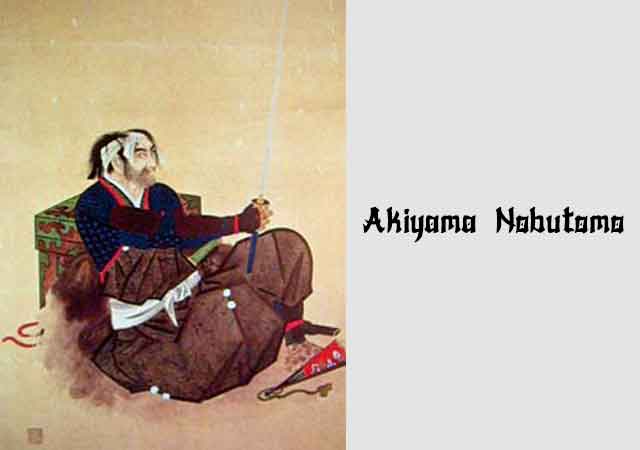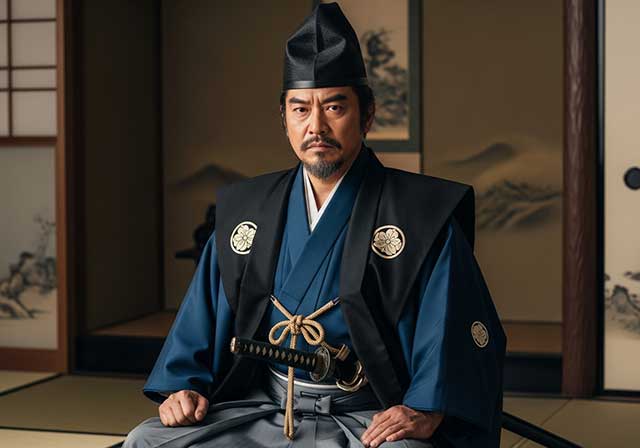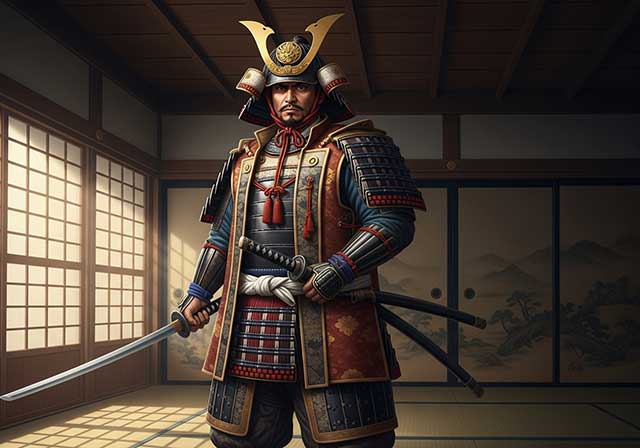
Akiyama Nobutomo (1527 – December 28, 1575) was a prominent samurai during Japan's Sengoku period. He is renowned as one of the "Twenty-Four Generals of Takeda Shingen" and also served under Shingen's successor, Takeda Katsuyori.
Nobutomo was born in 1527 at Tsutsujigasaki Castle in Kai province. His father, Akiyama Nobutou, hailed from a cadet branch of the Takeda clan and was a descendant of Takeda Mitsutomo. When Nobutomo reached adulthood, he entered the service of Takeda Shingen, the leader of the clan and ruler of Kai province in central Japan's mountainous region. In 1547, during the campaign for the Ina district, Nobutomo distinguished himself in battle and was granted a fief in the northern half of Ina, which corresponds to present-day Kamiina District in Nagano prefecture. Nobutomo's military prowess earned him the nickname Takeda no Mogyu.
By 1568, Nobutomo had gained enough respect to be entrusted with diplomatic missions. In that year, he represented his lord, Takeda Shingen, at the wedding ceremony of Oda Nobutada, the eldest son of Nobunaga, and Matsuhime, the daughter of Shingen, held at Gifu Castle.
In 1571, as part of Takeda Shingen's campaign against Tokugawa Ieyasu, Nobutomo was called back from Iida Castle to lead an invasion of Mino province. His progress was halted by Saigo Yoshikatsu's forces from the Saigo clan. The Battle of Takehiro ensued, resulting in Yoshikatsu's death, but Nobutomo was compelled to retreat.
In 1572, as the Takeda clan launched another campaign, culminating in the Battle of Mikatagahara in January 1573, Nobutomo descended from the north to cut off escape routes and block reinforcements. He laid siege to Iwamura Castle, which eventually surrendered through negotiations with Lady Otsuya, widow of Toyama Kagetou. This strategic move secured Nobutomo's position and aligned Lady Otsuya with him, ultimately resulting in her marriage to Nobutomo.
After Takeda Shingen's passing in 1573, Nobutomo continued to support Shingen's son, Takeda Katsuyori, in his military endeavors.
In 1575, Katsuyori suffered a devastating loss at the Battle of Nagashino, leaving Nobutomo isolated at Iwamura Castle without reinforcement. Despite enduring repeated sieges by Oda Nobutada's forces, Nobutomo and his troops held out until November when Oda Nobunaga arrived with the main army. Realizing that further resistance was futile, Nobutomo signed a truce to surrender the castle. Tragically, Nobunaga violated the truce, resulting in the execution of Nobutomo, his wife (Nobunaga's aunt), and the garrison troops.
On December 28, 1575, Nobutomo and his wife, Lady Otsuya, met their end through crucifixion on the banks of the Nagara River. His holdings in Shinano were then inherited by his eldest son, Akiyama Katsuhisa.
See also
-
Ouchi Yoshioki

Ouchi Yoshioki, the ruler of the provinces of Suo, Nagato, and Iwami, was one of the most capable military commanders and politicians of the late 15th and early 16th centuries. The son of Ouchi Masahiro, he governed from his residence in Yamaguchi in the province of Suo. In 1499, Yoshioki gave refuge to Shogun Ashikaga Yoshitane, who had been driven out of Kyoto by Hosokawa Masamoto. Shogun Yoshizumi, Masamoto’s protégé, ordered the lords of Kyushu to unite their forces against Yoshioki; however, they did not dare to do so, fearing the power of a man who by that time controlled six provinces. Having gathered a substantial army, Yoshioki marched from his native Suo toward Kyoto in order to restore Shogun Yoshitane to power.
-
Otomo Sorin

Ōtomo Yoshishige came from a noble lineage, being the eldest son of Ōtomo Yoshiaki, the ruler of Funai Province. The roots of the Ōtomo family traced back to Fujiwara Hidesato, the adopted son of Nakahara Chikayoshi. Fujiwara served Minamoto Yoritomo during the Genpei War and took part in battles in Mutsu Province in 1189. In 1193, he was appointed shugo of Buzen and Bungo Provinces, after which he adopted a new surname—Ōtomo.
-
Okudaira Sadamasa

Sadamasa was the son of Okudaira Sadayoshi and took part in several battles under Tokugawa Ieyasu, distinguishing himself in the Battle of Anegawa in 1570, where he took two heads. Around 1572 he was forced to enter the service of the Takeda clan, but after the death of Takeda Shingen in 1573 he returned to Tokugawa, leaving Tsukude Castle together with his men. As a result of this defection, Takeda Katsuyori ordered the execution of Sadamasa’s wife and brother, who were being held as hostages.
-
Okubo Tadatika

Tadatika, the son of Okubo Tadayō, entered the service of Tokugawa Ieyasu at the age of eleven, and took his first head in battle when he was sixteen. After the establishment of the Tokugawa shogunate, he was appointed as a rōjū — a senior bakufu official — and was regarded as one of Ieyasu’s most trusted advisors, alongside Honda Masanobu. He is also known for his military chronicle Mikawa Monogatari, which describes Ieyasu’s rise to power and the early years of the Tokugawa shogunate.
-
Okubo Nagayasu

Nagayasu was the second son of Okura Nobuyasu, a sarugaku theater actor from the Takeda clan. Takeda Shingen recognized the young man’s potential and took him into service, appointing him as a vassal to his general, Tsuchiya Masatsugu. During this period, Nagayasu changed his family name to Tsuchiya. He was entrusted with developing the Takeda clan’s gold mines as well as handling matters related to taxation.
-
Nitta Yoshisada

Nitta Yoshisada was a loyal soldier of Emperor Go-Daigo, who in the 1330s attempted to restore direct imperial rule in Japan. The Nitta family was related to the Ashikaga house and was older in lineage. However, they did not join Minamoto Yoritomo at the start of his war with the Taira, as the Ashikaga did, and therefore did not receive high positions in the Kamakura shogunate. This may have been one of the reasons why Yoshisada rose against the Hōjō clan in 1333.
-
Natsume Yoshinobu

Yoshinobu, a long-time vassal of the Matsudaira and Tokugawa clans, governed Hamamatsu Castle on behalf of the Tokugawa house. During the clashes between the Imagawa, Takeda, and Matsudaira clans, he served in the garrison of Nagasawa Castle and in 1562 took part in raids under the command of Itakura Shigezane. When, in 1563, a revolt of the Sōtō-shū sect followers broke out in Mikawa Province, Yoshinobu joined the rebels together with Honda Masanobu and Hachiya Sadatsugu.
-
Nambu Nobunao

The Nambu clan was an ancient and powerful family that traced its lineage back to the Minamoto shoguns and had controlled a significant part of the Tohoku region in northern Honshu since the 12th century. Nobunao was born in Ikatai Castle, located in what is now the city of Iwate. He was the second son of Ishikawa (Nambu) Takanobu, the 22nd head of the Nambu clan. In 1565, Nobunao’s uncle, Nambu Harumasa, adopted him, brought him to Sannohe Castle, and named him his heir, later giving his daughter in marriage to him.

